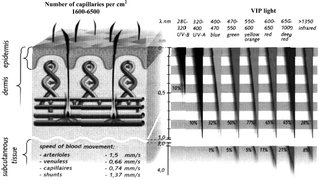Enhancement of the blood growth promoting activity after exposure of volunteers to visible and infrared polarized light. Part I: stimulation of human keratinocyte proliferation in vitro
Abstract
The systemic mechanisms of the wound healing effect of low intensity lasers remain largely uninvestigated. The goal of this randomized, placebo controlled, double blind study is to prove that irradiation of a small area of the human body with visible and infrared polarized (VIP) light (400–3400 nm, 95% polarization, 40 mW cm2, 12 J cm2) leads to an increase of the growth promoting (GP) activity of the entire circulating blood for primary cultures of human keratinocytes (KCs).
Thirty minutes after the VIP-irradiation of a sacral area of volunteers, the GP activity of circulating blood was seen to increase through the elevation of the number of KCs cultured with the isolated plasma by 20 ± 3%, p < 0.001. A similar increase in GP activity was seen in plasma derived from the in vitro irradiated blood of each volunteer, and from the mixture of irradiated and non-irradiated autologous blood (1 ∶ 10). Enhanced GP activity was also recorded at 24 h after the 1st and 4–9th daily phototherapeutic sessions. Hence, exposure of volunteers to VIP light leads to a fast increase in the GP activity of the entire circulating blood for human KCs in vitro, which is a consequence of the transcutaneous photomodification of blood and its effect on the rest of the circulating blood volume.


 Please wait while we load your content...
Please wait while we load your content...